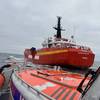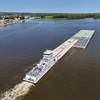Scientists Produce Data from Largest Single Volcano
Tamu Massif is a volcano the size of New Mexico and lurks 6,500 feet beneath the surface of the Pacific Ocean. During their 36 day expedition, the science team undertook a survey of immense proportions mapping an area nearly one million square kilometers in size. Not only were they able to gather new high-resolution acoustic imagery of this little known volcano, but they also collected 1.7 million magnetic measurements to better understand how such a large volcano was formed. The rocks of the giant volcano record the Earth’s magnetic field at the time they were erupted, giving scientists clues about the timing and process of eruption.
The science team aboard R/V Falkor led by University of Houston marine geophysicist Dr. William Sager, were able to gather an immense amount of data, and already have some very interesting findings. Dr. Sager thinks that they may have found another mountain on the west end of the volcano that could have formed at the same time as Tamu Massif. “One thing that stands out about this survey is its sheer size. It was an ambitious cruise to cover all of Tamu Massif, the world’s largest known single volcano”, said Sager. “In all, we spent about 477 hours collecting data over the volcano, which will allow us to produce the best bathymetry map ever of Tamu Massif.”
In addition to the science objectives, the science team connected live with over 4000 students and teachers across the globe, giving them a taste of science at sea. Texas State Aquarium Manager of Distance Learning and Outreach Suraida Nañez-James sailed on Falkor and lead the classroom connections. “The best part of this expedition has been the opportunity to bring teachers and students along on our exploration”, said Suraida. “They became part of our journey, and we were able to bring the experience of history-making research into the classroom. It is this type of education outreach that truly inspires the next generation of scientists to continue exploring and conserving our oceans.”
The science team comprising of researchers from University of Houston, Texas A & M University, and Chiba University, will now return home to process and analyze the data that were collected. All data obtained during the expedition are made publicly available by Schmidt Ocean Institute. Support for this expedition was provided by Schmidt Ocean Institute, National Science Foundation (NSF), National Geographic Society Committee for Research and Exploration, and Texas State Aquarium. Schmidt Ocean Institute provides ship time aboard R/V Falkor and the equipment required at no cost.















